When discussing market leaders in the SEO field, we often think about Semrush or Serpstat. Both of these have been around for quite a while, with rich experience in search engine optimization, marketing, PPC, and many other factors. Semrush is often regarded as the best SEO tool. On the flip side, Serpstat comes with affordable plans that make it attractive. Both of these offer a fair share of features. They’ll help you improve your website and ensure it ranks higher by the day.
However, in this Serpstat vs Semrush comparison, one must win. To declare the winner, we must go through several tests and compare their features side by side. In the end, we’ll see who won more rounds and is, therefore, the winner of today’s duel.
Semrush vs Serpstat: Our Quick Conclusion
If you don’t want to read the entire thing, here’s our quick conclusion. Semrush WINS today’s duel by being a more quality SEO tool. No doubt, it’s a way better option than Serpstat but still, let us list a few reasons for using each of them.
Semrush is best for:
- More in-depth keyword research
- Backlink auditing
- Link building
- On-page search engine optimization
- Robust PPC research
- Social media tracking
- Ease of use
Serpstat is best for:
- AI-driven content writing and generation
- Cheap subscription plans (from $50 a month)
- API access in all plans
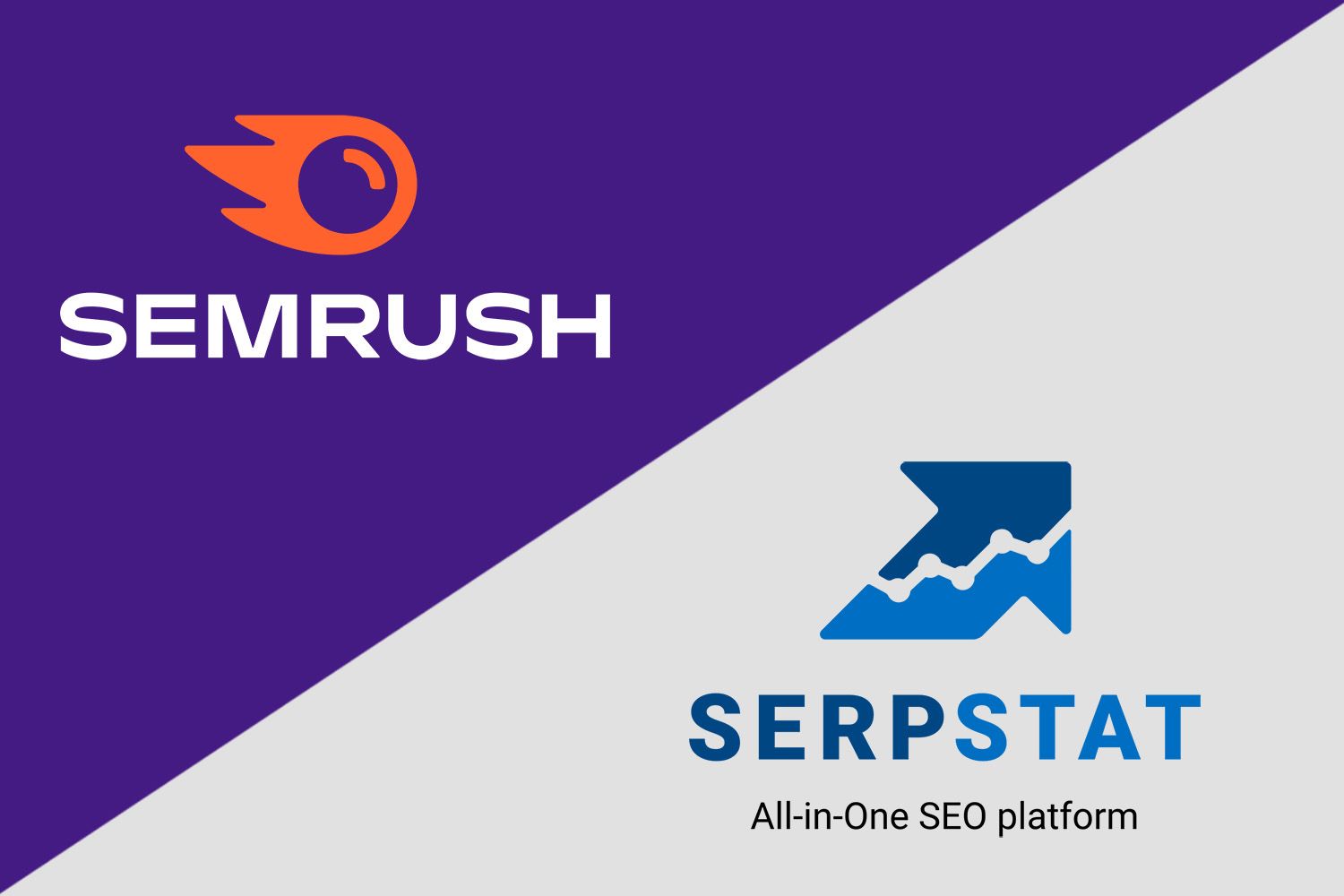
Semrush vs Serpstat Features Comparison
There’s no better way to start this duel than discussing Semrush and Serpstat’s features. After all, we think this is what will interest you the most. The sheer power of each tool – or perhaps, the lack of it? Let’s see who brings more to the table.
Domain Research
Right off the bat, we notice that Semrush is ahead of Serpstat in domain research. Both, however, function the same. Type in the domain address and both tools divulge relevant information in merely 2-3 seconds. What do you get as a result?
Well, with Serpstat, you’ll find data like visibility, estimated search traffic, organic keywords, and paid keywords up top. We think its domain research function is more focused on keywords and keyword distribution, with a few tidbits related to subdomains and top pages.
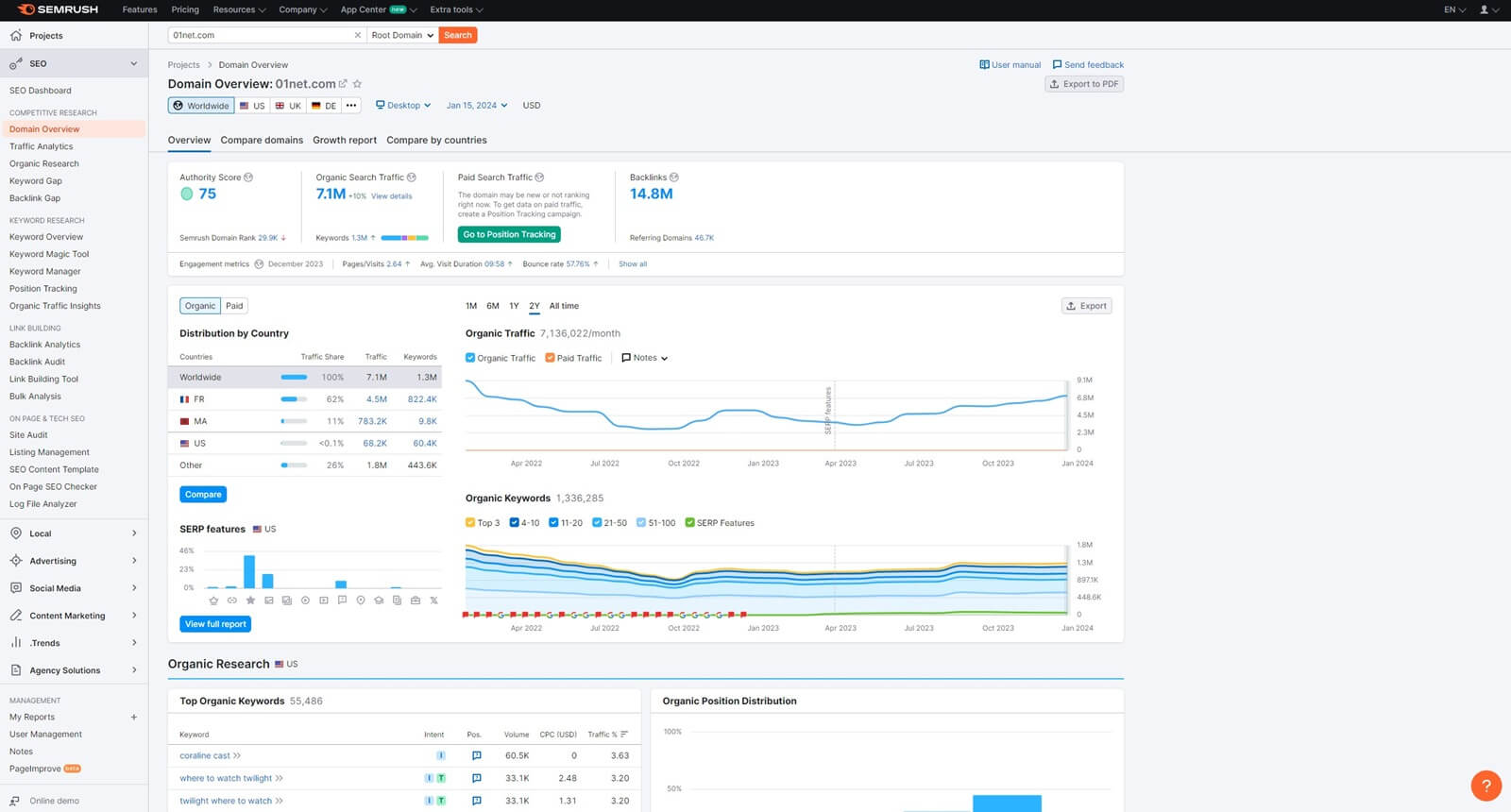
Semrush, on the other hand, shows you the authority score, backlinks, traffic distribution by country, and even keyword search intent, which we’ll discuss later. We also love Semrush’s competitive positioning map, where you can see how you stack against your rivals.
Serpstat’s domain research isn’t as thorough as Semrush’s equivalent. For example, it lacks the aforementioned authority score and offers fewer bits of information in general. One instance we want to mention is the number of backlinks and referring domains.
For the same site (01net), it discovered fewer of them compared to Semrush. That might be due to a smaller backlink database that makes the information accuracy suffer. Either way, we like Semrush more for domain research thanks to more provided information and the way the information is presented, which comes down to the interface.
Keyword/Backlink Gap
Proper keyword dispersal is vital to rank higher, especially amidst harsh competition. In the same fashion, backlinks are crucial, for which keyword and backlink gap tools are here. The keyword gap tool lets you compare your domain to three other competitors.
This way, you can see the keywords your competitors rank for but you don’t, letting you include them on your website. The backlink gap tool allows you to compare your domain to the same number of rivals but this time, with a different goal.
It enables you to see which websites link to your competitors but not yours. After finding this out, you can use Semrush’s link-building tool to contact these sites and request a backlink. More about that later in this Semrush vs Serpstat test.
Domain vs Domain
Serpstat offers the features titled Domain vs Domain. It functions similarly to the keyword gap tool in Semrush. In the basic plan, however, it lets you compare your domain to TWO others rather than three in Semrsuh – a bit disappointing.
An intuitive thing is that it puts out recommendations on which competitors to choose. For 01net, our domain, Serpstat displayed our true competitors that we could check out. Either way, you’ll get a graph displaying the total and unique KWs of each domain.
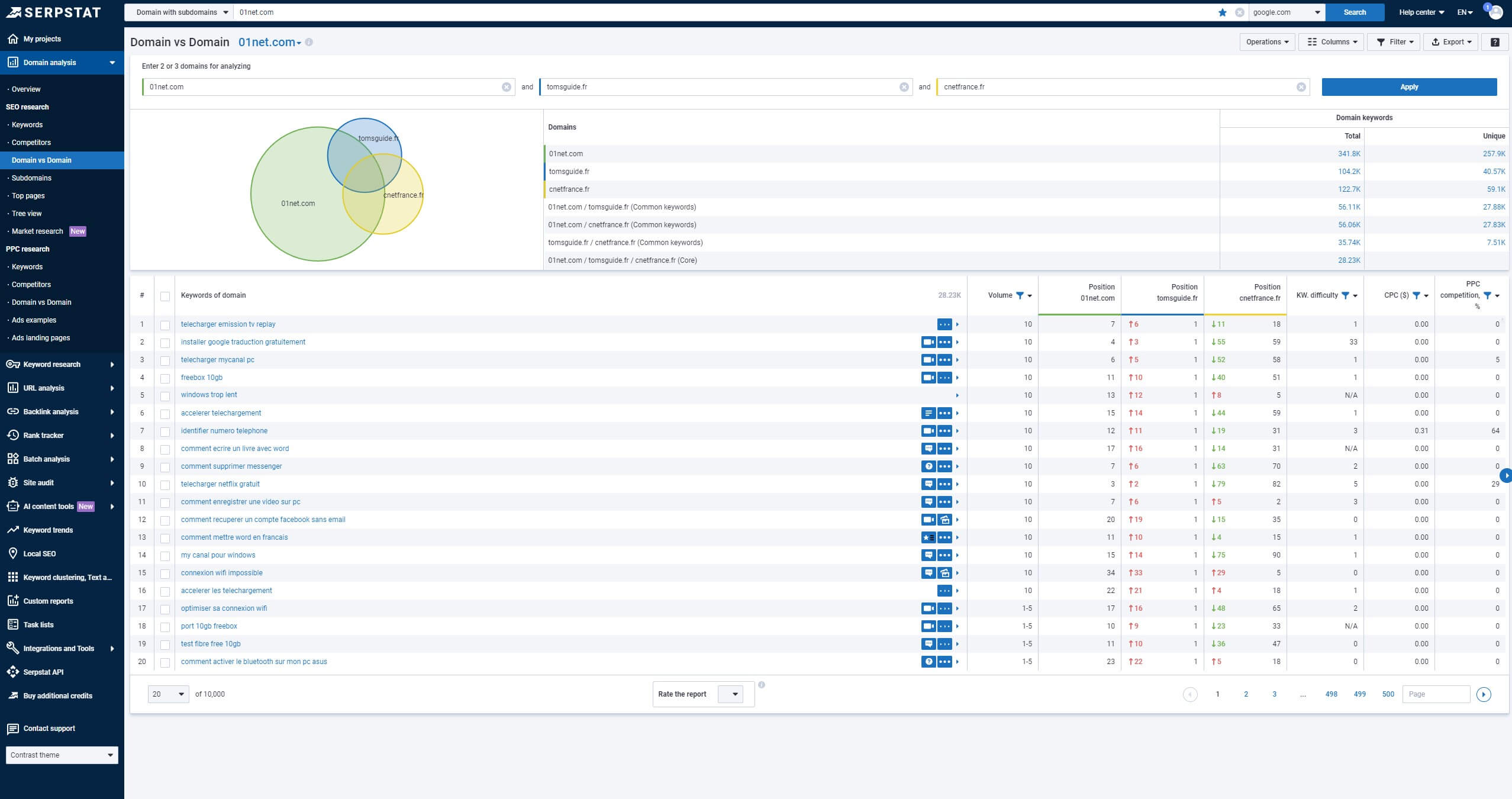
Below, you’ll see keywords, their volumes, and positions for each website. We like that Serpstat even displays SERP features to help you better understand the keywords. For example, some of them have a video thumbnail, related questions, and so on.
Basically, the feature shows you the keywords the three websites SHARE and how high they rank for each search term. Again, it’s not the keyword gap tool but it helps to rank better by including a specific keyword or its long-tail words more often.
Advertising Research (PPC)
Now, we should go over PPC research in the Serpstat vs Semrush duel. Semrush wins this round as well, as it offers more information about your competitors, their anchors used for advertising, and so on. Serpstat offers similar options.
For example, you can again compare domains and check their paid keywords. Another thing you can do is see ad examples, where you’ll discover which keywords competitors use for their PPC campaigns. Better yet, you can see ad landing pages in Serpstat!
Semrush isn’t far off – actually, it’s in front, leading the pack. You’ll promptly discover which keywords your competitors are “chasing” for their PPC campaigns and see the CPC for each. One metric we like is Seasonality.
This metric displays the advertising spend of your competitors and its change over the year. Moreover, Semrush lets you discover new competitors in Google Ads with their keywords, paid traffic estimation, and every other factor needed for a full PPC report.
To top it all off, Semrush includes PLA Research, which you won’t find in Serpstat, or even SpyFu. This option analyzes the performance of the advertiser’s Google Shopping ad campaign. Alas, PLA Research is available only in the Business plan with a hefty price tag.
Keyword Research
Keyword research is handy when you want to quickly analyze the performance of a given keyword. Type in the keyword(s), press Enter, and you’re there. Both tools will display information like volume in the country you selected, keyword difficulty, and CPC.
In Serpstat, you’re getting information about the country you’ve chosen. However, Semrush includes this info, along with the keyword volume in other countries, such as India, the UK, Germany, and a few others. In the same menu, you get plenty of keyword variations!
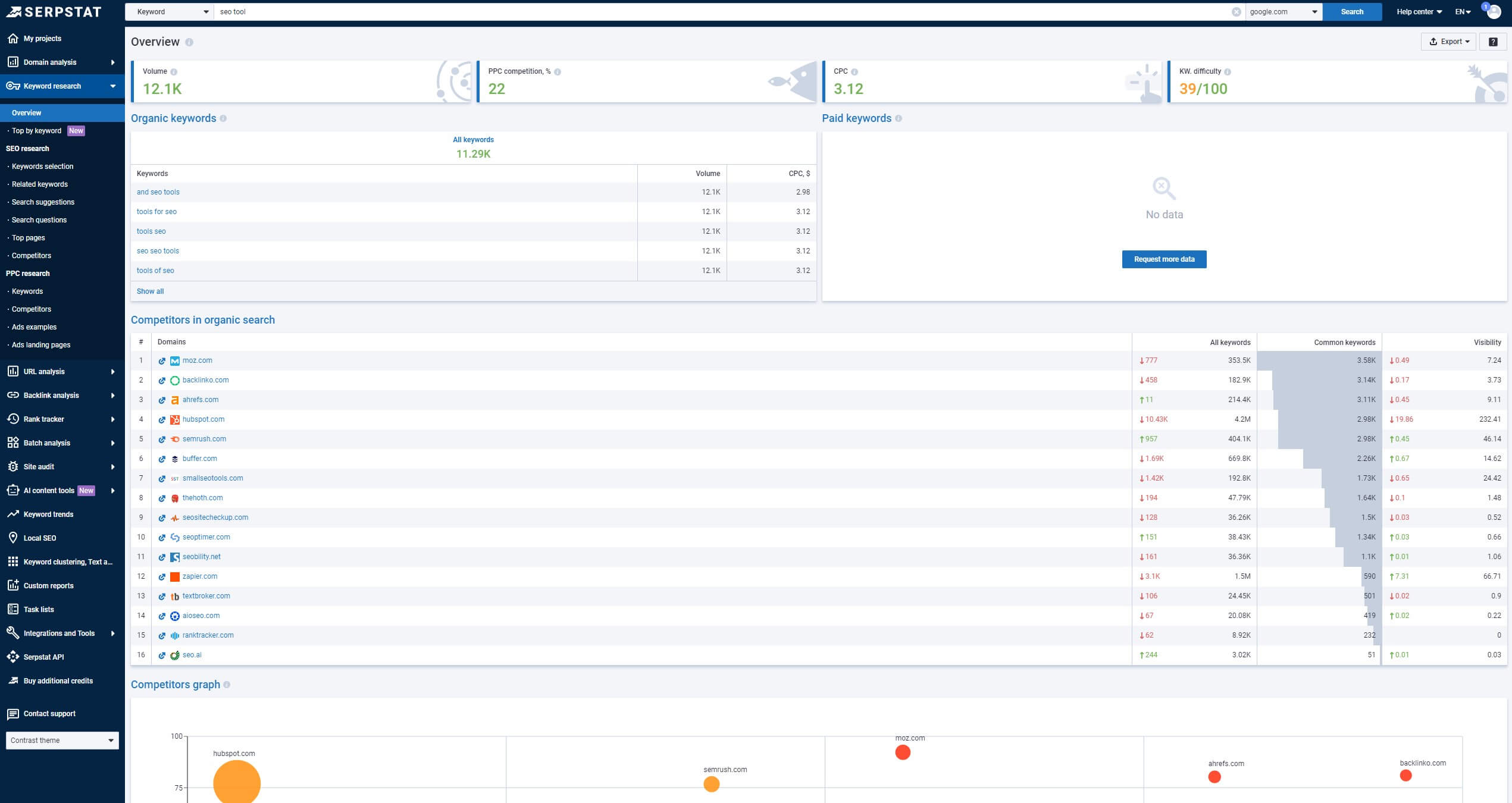
Semrush gives you many keyword recommendations and related questions, which we found handy. Serpstat misses the mark this time, and the keyword overview menu includes just organic keyword recommendations, competitors in organic search, and ads examples.
Also, the keyword difficulty is a huge discrepancy between Semrush and Serpstat. For the same keyword, Semrush came back with a difficulty of above 90% at the time, while in Serpstat, the difficulty was only 39/100. Mind you, the keyword was “SEO tool.”
Do you think this keyword is THAT easy? 39/100 means you should be able to rank for it without hassle. We dislike that Serpstat is too “mild” and won’t give you an accurate representation of how difficult the keyword is.
For this metric, Ahrefs and Semrush are industry leaders, with extremely accurate data.
Search Intent
Okay, so search intent isn’t available in Serpstat, which is a shame. This metric helps you discover the intent behind the user’s search for a specific keyword. It looks like this:
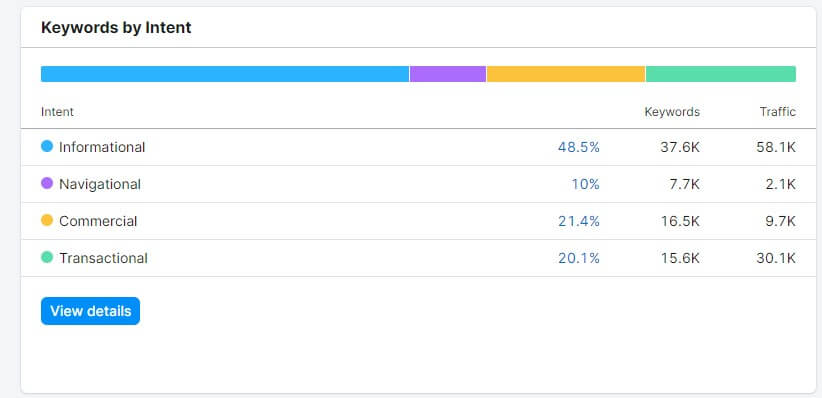
Semrush has four categories, including Informational, Navigational, Commercial, and Transactional. If the intent is informational, the keyword won’t convert well, as it’s mostly used for people to gain more information about a product.
However, the Commercial intent means the user is highly likely to make a purchase when he/she types in the keyword. With this metric, you’ll know how and when to implement the keyword you’re after, depending on your goal.
Keyword Magic Tool
We mourn the lack of the Keyword Magic Tool in Serpstat. This one is ingenious. You provide the keyword and immediately get a load of suggestions for it. Semrush displays difficulty, volume, and trend next to each, along with intent and CPC for advertising campaigns.
For our needs, the Keyword Magic Tool is pitch-perfect. We use it to boost our Google ranking and ensure all articles are properly optimized. Even better, you can use this tool to research keywords in multiple languages, which is extremely useful for foreign domains.
Users can discover more specific keywords as well to make conversions more effective. Also, Semrush lets you discover longer keywords that will help smaller domains tackle very specific user needs, and again, make more conversions.
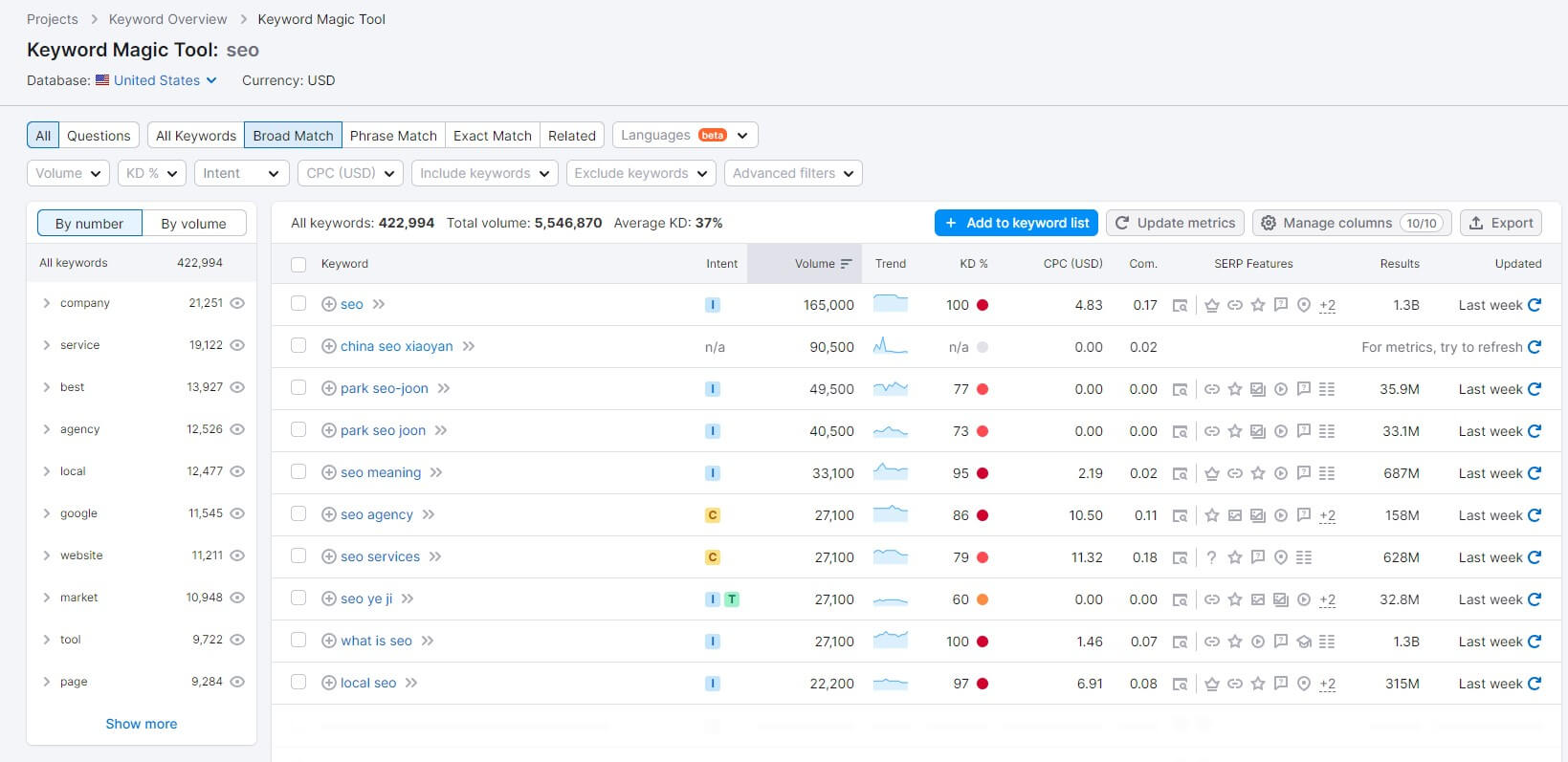
The Keyword Magic Tool is state-of-the-art. We praised it multiple times in our comprehensive review of Semrush. Be sure to read it to find out more about this excellent SEO tool. Serpstat has a few things going on but nothing particularly similar.
Its related keywords, search questions, and suggestions are separately put in another tab. However, they’re nowhere near as in-depth and numerous as Semrush. Additionally, the basic plan doesn’t have filtering options, so you just get these random keywords without any sense. Just difficulty, volume, and CPC.
Search Suggestions are even worse and are displayed WITHOUT these bits of information, so there’s even less context. This is why, in this Semrush vs Serpstat duel, the first tool takes the lead and makes the latter pale in comparison.
Keyword Manager
Serpstat supports keyword clustering, which is handy for grouping keywords and having them ready for the next marketing plan. However, this feature is locked behind the paywall of the more expensive plan. Semrush is more generous, offering its Keyword Manager in all plans, even in the free version.
The Keyword Manager can do a few things. First, you’ll enter a few keywords – up to 5 – and Semrush will come with ready-made clusters. This way, it provides you with new content ideas and keywords that would help you bring them to fruition.
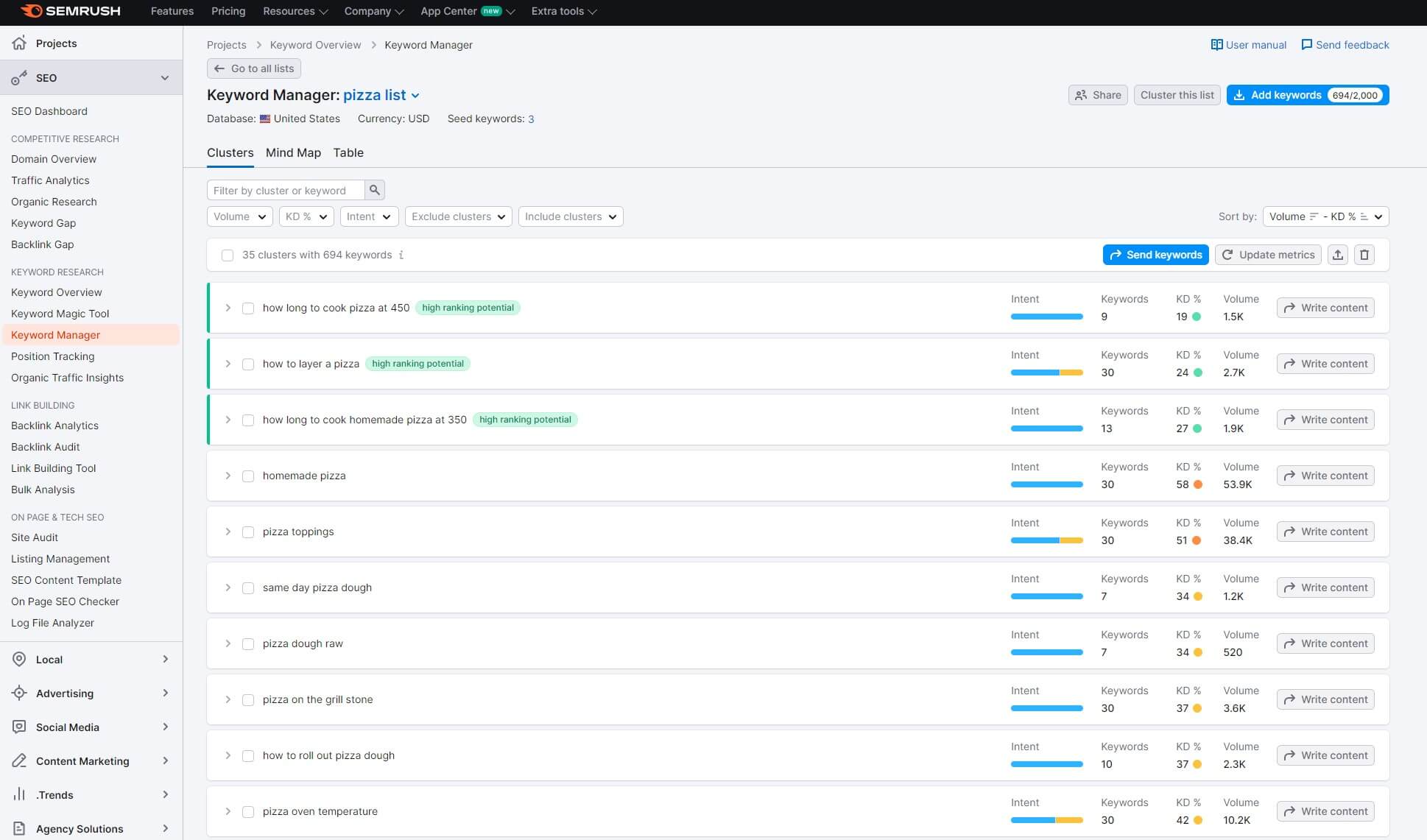
This tool also offers a comprehensive Mind Map where you can analyze related questions and keywords easily. Semrush’s simple interface lets you save these clusters and inspect their difficulty and volume to determine whether they’re worth doing.
In fact, Sermush will help you by displaying clusters with more potential first. In Serpstat, this tool is much barer, so to speak. It feels like an afterthought compared to Semrush, providing fewer keyword clusters for the given seed keywords. It’s not worth paying for additionally.
SEO Content Template
When discussing keywords, we want to briefly mention Semrush’s SEO Content Template feature. It analyzes the keyword and comes up with a few bits of handy information. For example, it displays semantically related words, also known as LSI keywords.
For each keyword, it also advises you on the text length and how many words you should aim for to cover the topic. This tool also presents to you the top 10 rivals and their articles that cover the topic, giving you a better overview of things to cover.
Finally, the SEO Content Template offers recommendations regarding the H1/page title, meta description, and keywords to include in the text part of the page. You won’t find anything remotely similar in Serpstat.
Rank Tracking
In this Semrush vs Serpstat duel, the latter includes rank tracking – but alas, it’s available only in the more expensive plan. At least the feature is capable of allowing you to track a heap of keywords with daily ranking updates. Even better, you can see your position history.
We like that Serpstat lets you include several competitors and compare their rankings to your domains. Moreover, we often used the option to analyze URLs and inspect specific pages to track their rankings and see how well they perform.
In Semrush, position tracking works well – better than Serpstat, we’d say. Again, you’re getting daily updates. Not weekly like in Ahrefs (see our Ahrefs alternatives here). However, Semrush displays more data, such as rankings distribution, top keywords, and visibility.
For example, there’s a list of keywords with a negative and positive impact on the ranking. Then, the tool includes Cannibalization reports where you can see which pages rank for the same keyword, and therefore, “eat” each other. This way, you can fix the problem.
Like Serpstat, Semrush lets you discover SERP features and track your ranking across hundreds of countries. In short, Semrush wins by an even larger margin this time, offering industry-leading keyword research functions that you won’t find in Serpstat.
Link Building/Backlink Analysis
In a guide we wrote not so long ago, we explained the importance of backlinks for ranking. Simply put, they’re vital. With this in mind, this Serpstat vs Semrush duel brings us to this factor, which both SEO tools offer in all of the plans.
Starting with Serpstat, its backlink analysis is in-depth at first. You’re getting the number of referring domains, backlinks, and external domains up top. From here, you can see your new and lost backlinks, backlink distribution, and top anchor backlinks by popularity.
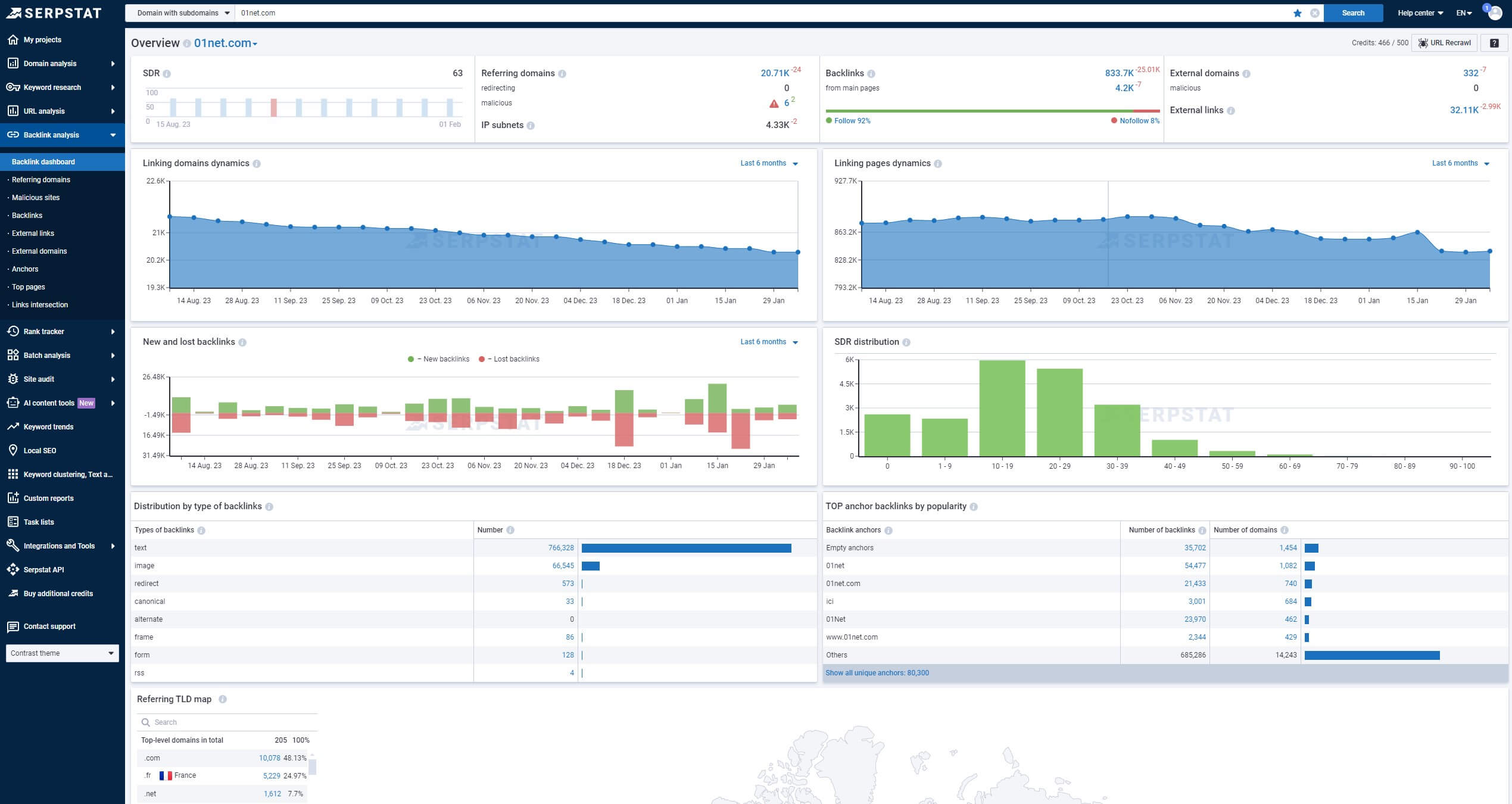
Semrush, however, offers a few more bits of data. For one, there’s the Authority Score, which shows you how powerful and authoritative the domain is. It’s calculated based on the natural profile, link power, and organic traffic.
In the Backlink Analytics tab, Semrush displays the number of monthly visits, organic traffic, and outbound domains. We also like its information about link attributes that show the percentage and number of follow, nofollow, sponsored, and UGC links – quite handy.
In Serpstat, you can find almost identical information but in separate menus, which makes things a tad more complicated. However, the authority score is titled SDR (Serpstat Domain Rank) and is calculated solely by the number of websites that lead to the analyzed site and the number of sites linking to these websites.
Backlink Audit
In our Semrush vs Serpstat comparison, we found another notable difference. Serpstat doesn’t offer backlink audit tools but it does offer the Malicious Sites tool. This tool essentially detects links to malicious sites and helps you remove them.
What’s the catch? It’s locked behind the paywall – you have to get a more expensive plan! Semrush is for many people expensive but hey, at least, it gives you a wealth of tools like proper backlink auditing WITH toxic backlinks detection!
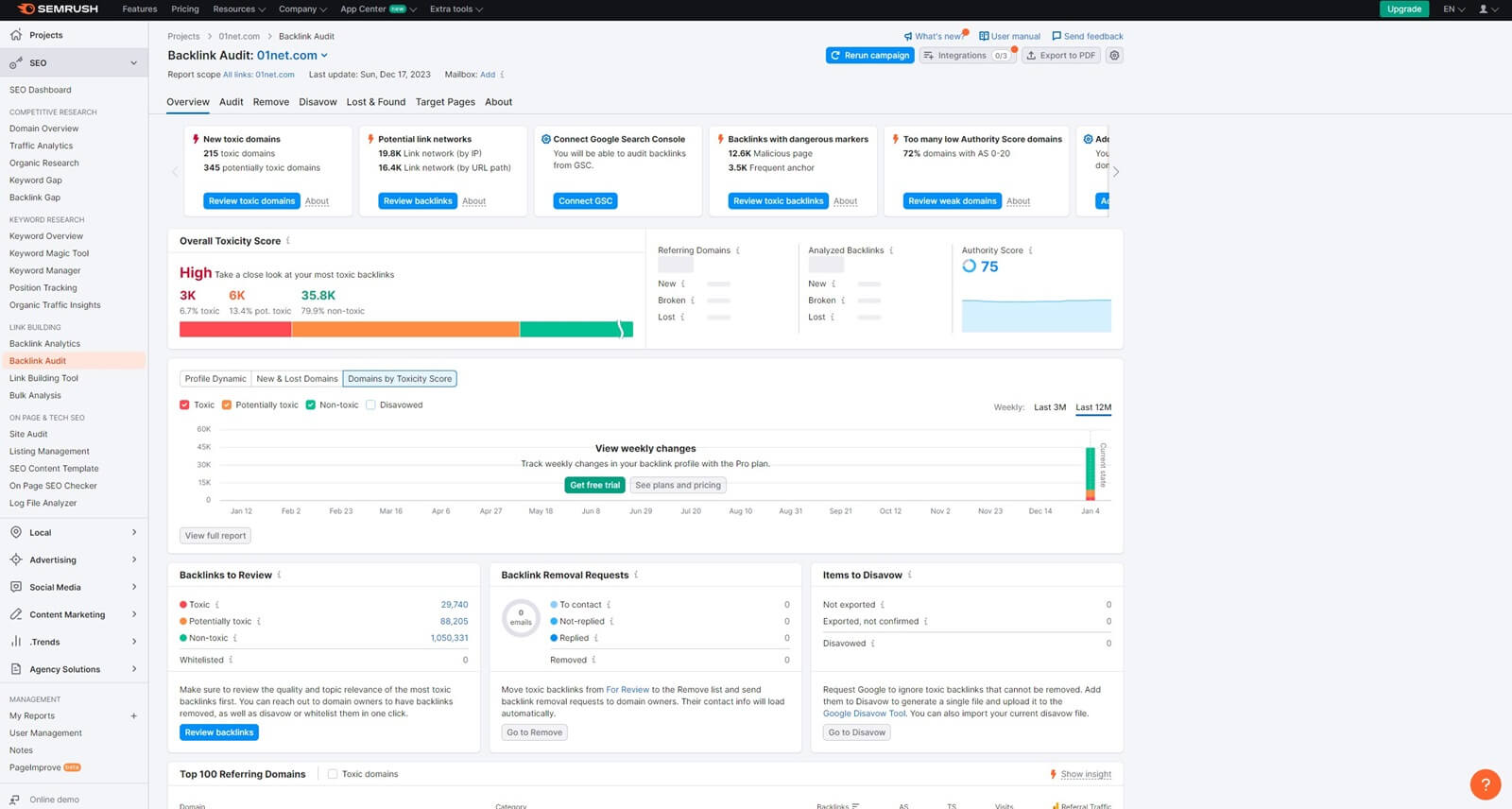
Enter the domain address and get information about the toxicity score. From here, discover toxic backlinks and remove them from your site. Furthermore, Semrush allows you to disavow the backlinks you want Google to ignore, thus, preventing them from harming your ranking in the long run.
Semrush will carefully analyze all your backlinks and display potentially toxic and non-toxic ones. This way, you can see what you’re doing well and not just bad things. Removed backlinks will be placed in the “Remove” tab, where you can review them further.
Link Building
Link building is simple with Semrush’s CRM-like prospect overview. Let us explain. The link-building tool allows you to discover potential backlink opportunities that Semrush titles Prospects. You will be offered hundreds, sometimes thousands of these.
Basically, these are high-quality backlink opportunities from websites with notable authority in your niche. Using Semrush, you can directly contact each site through email and request a backlink or guest post. In doing so, the prospect will be moved to the “In Progress” tab.
From here, you can track it and see what happens with the backlink request. We find this feature very handy, as it makes the process of reaching out to website owners and collaboration far simpler. Sadly, no such feature is in Serpstat.
The only thing you’ll find is the Link Intersection tool – again, locked to the more expensive plan. However, it functions similarly to the Backlink Gap in Semrush, allowing you to discover missing backlink donors that you can contact for a backlink.
Site Auditing
While it lacks backlink auditing, Serpstat at least allows for in-depth site audits. Like Semrush, it requires you to provide the domain address and after a few minutes, it gathers all the information you have to know. Semrush is, however, a bit faster in this regard.
Serpstat comes out with issues and recommendations to apply to fix them. It also ranks these issues according to priority, highlighting in red those with the highest priority. We can say the same about Semrush, whose Site Audit tool is simple and easy to grasp.
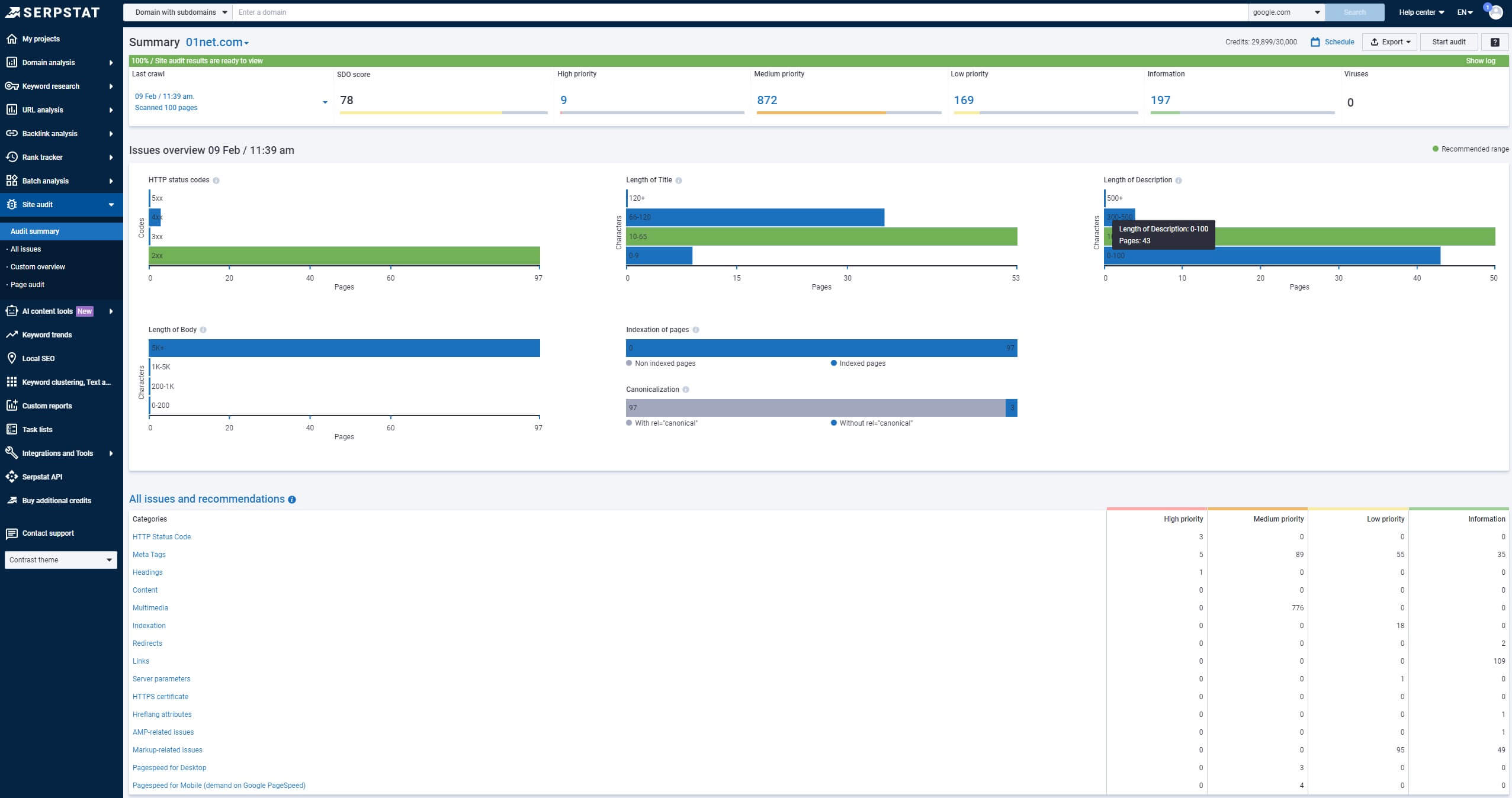
Both tools will not only display recommendations but also explain them. For example, we found a few issues with meta tags. When we clicked on this problem, both Serpstat and Semrush explained the core of the problem and the exact method to fix it.
Semrush and Serpstat have a different scoring system. Semrush uses the Site Health score, while in Serpstat, you have this SDO (Serpstat Domain Optimization) score. In Semrush, our analyzed domain received 80, while in Serpstat, it received 78 points – pretty similar.
On-Page SEO
We like that Serpstat and Semrush include on-page SEO tools. This will improve your Google ranking and ensure each page is working as intended. It’s basically the same tool but aimed at specific pages you want to optimize. At least in Serpstat.
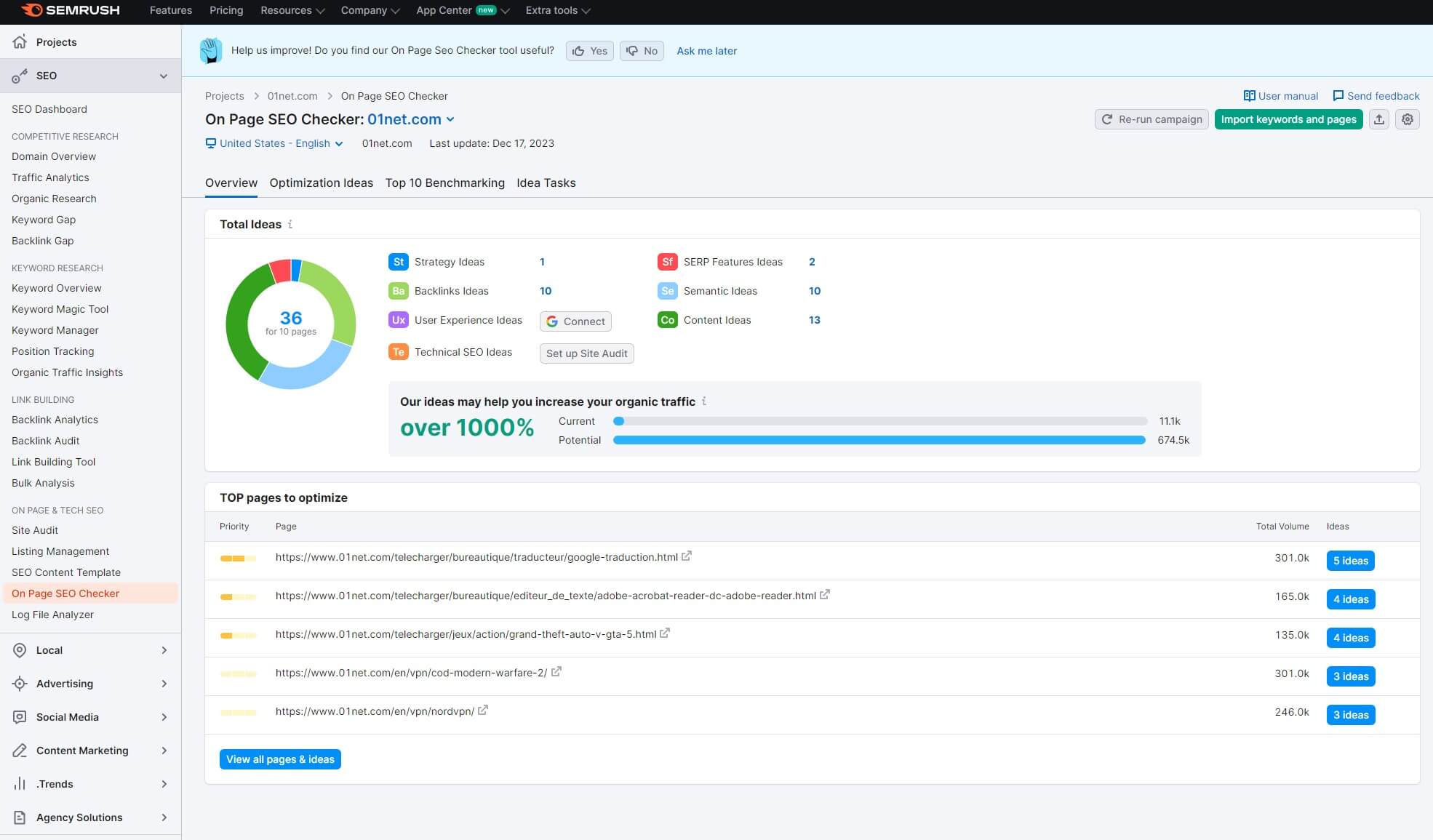
With Semrush, you’re getting a bit more. The On-Page SEO Checker will display so-called ideas that you can implement to further optimize the page. These ideas have to do with SEO strategy, user experience, technical SEO, SERP features, content, semantics, and so forth.
You can use Semrush to make the page top-notch both in terms of technicalities and content quality. Sadly, Serpstat isn’t so in-depth and won’t display as many ideas and optimization advice but that’s not to say it’s incapable – it’s more than great.
Content Marketing
Content Marketing is another worthy subject to cover in this Serpstat vs Semrush comparison. In Semrush, Content Marketing revolves around:
- Topic Research
- SEO Writing Assistant
- SEO Content Template
Since we covered the last entry a second ago, we need to discuss its Topic Research and SEO Writing Assistant options. Before we do that, we’ll inform you that Serpstat includes many similar tools to these. More of them, we should add.
Semrush
Semrush comes with the Topic Research tool that allows you to find new topics to cover. You’ll provide the tool with your domain and get recommendations along with their volumes. Semrush will also advise you on which keywords and questions to use.
For the most part, this tool works perfectly and comes up with the topics you can cover on your site with great success. Other times, Semrush comes up with some nonsensical stuff that has nothing to do with your niche. It can be funny at times.
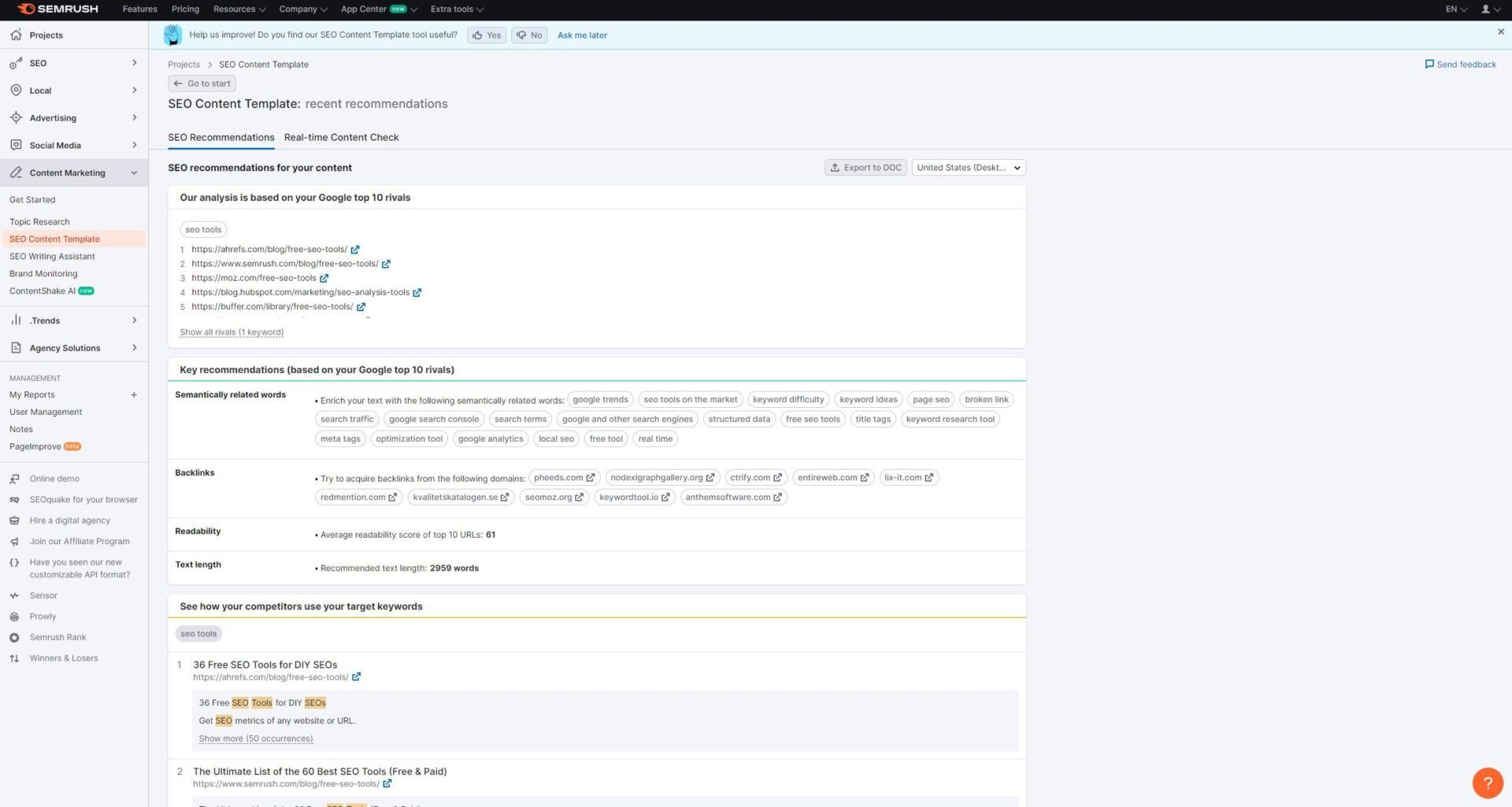
However, you can narrow the search by searching for specific content on the domain and prioritizing topic efficiency over volume. The SEO Writing Assistant is your primary tool for content editing, optimization, and readability improvement.
It ranks your text according to readability, voice tone, originality, and SEO. Then, you get various advice on which target keywords to implement, how to improve your writing, and bb more original. It functions similarly to Grammarly, which can be used as a free SEO tool.
The service includes this ContentShake AI too. It’s paid $60 a month over the subscription but allows for 25 new content ideas weekly, unlimited articles, and rewriting features. The free plan is here but it’s quite limited in comparison.
Serpstat
Serpstat has a huge array of features that could belong to the Content Marketing category. For example, there’s a text editor that can also generate new content with an AI in multiple languages. Then, Serpstat has this Title Generation tool for crafting interesting titles.
Basically, Serpstat uses AI to create titles, text, and descriptions for your articles, pages, or blog posts. We like its plagiarism checker too, as it will determine whether your article has plagiarism that could ruin your ranking. Thanks to it, you can make your pages unique.
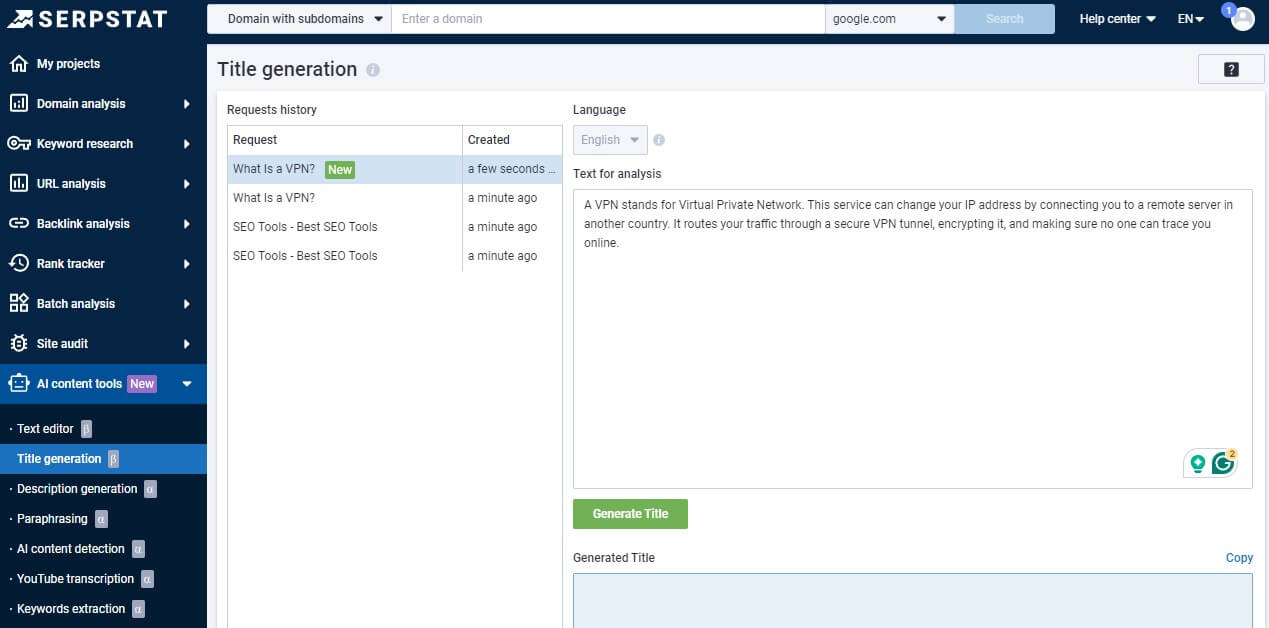
One of the best features is this YouTube Transcription. You provide the URL to the YouTube video and Serpstat transcribes it. It converts a video to an article and in doing so, avoids plagiarism that Google can easily smell.
Another feature worth mentioning is the Article Builder. Here, you provide a list of keywords and titles, tweak a few other parameters, and let Serpstat do the job. Semrush doesn’t offer some of these tools and if it does, they’re in the App Center and paid additionally.
However, Serpstat isn’t perfect. We tested these tools and their quality is… well, questionable. The articles and titles it creates aren’t always well written, plus, ALL of these AI tools require credits. Does this remind you of Ahrefs? A little perhaps?
Each plan comes with a different amount of credits that you can use via a Serpstat API token. To get this token, you have to provide your phone number to get an SMS. Then, simply paste the token into the empty field and use AI features from Serpstat. Such a chore at times.
Other Features
Unlike Moz Pro, Semrush comes with an array of other SEO and marketing features. It includes social media monitoring and even local SEO tools to rank your company’s website higher in your country or region. Tools like Trends and Agency Solutions are there too.
Bear in mind that most of Semrush’s tools that don’t directly impact SEO are paid additionally and honestly, they’re not the cheapest. As mentioned in our Serpstat vs Semrush duel, the latter has the App Center where you can find 30+ apps for different purposes.
This drastically improves Semrush’s capabilities but also makes it more expensive. Both tools offer API access in more expensive plans (Serpstat offers it in the cheapest plan), allowing for more integrations. Without API access, Serpstat is still impressive, letting you use the ChatGPT plugin and Airbyte Connector.
Serpstat connects seamlessly with Google Sheets and Looker Studio but also with apps like Excel and Reportz. However, Semrush can be integrated with many of these, in particular, Looker Studio used for creating highly detailed custom reports.
Serpstat lacks social media monitoring/posting capabilities and its local SEO features aren’t as prominent. On the flip side, all of the aforementioned features are in the service and you don’t have to buy them separately. Plus, API access is readily available for most users.
In Semrsuh, it’s reserved for Business plans and its App Center apps, especially better ones, can be very expensive, increasing the overall price dramatically. This round, therefore, ends up in a draw, as each tool has plenty of good but also a few bad things.
Serpstat vs Semrush: Ease of Use
We’ll tell you right away that we prefer Semrush over Serpstat. Semrush looks so good. It’s easy to get into and use, plus, it’s much faster when analyzing larger domains or multiple websites simultaneously. On top of that, its graphs are comprehensive.
At first, it can look intimidating like a huge bodybuilder on steroids. However, once the initial “whoa” reaction passes, Semrush becomes timid and easy to handle. It’s amazing how it manages to provide so many bits of information with exceptional clarity.
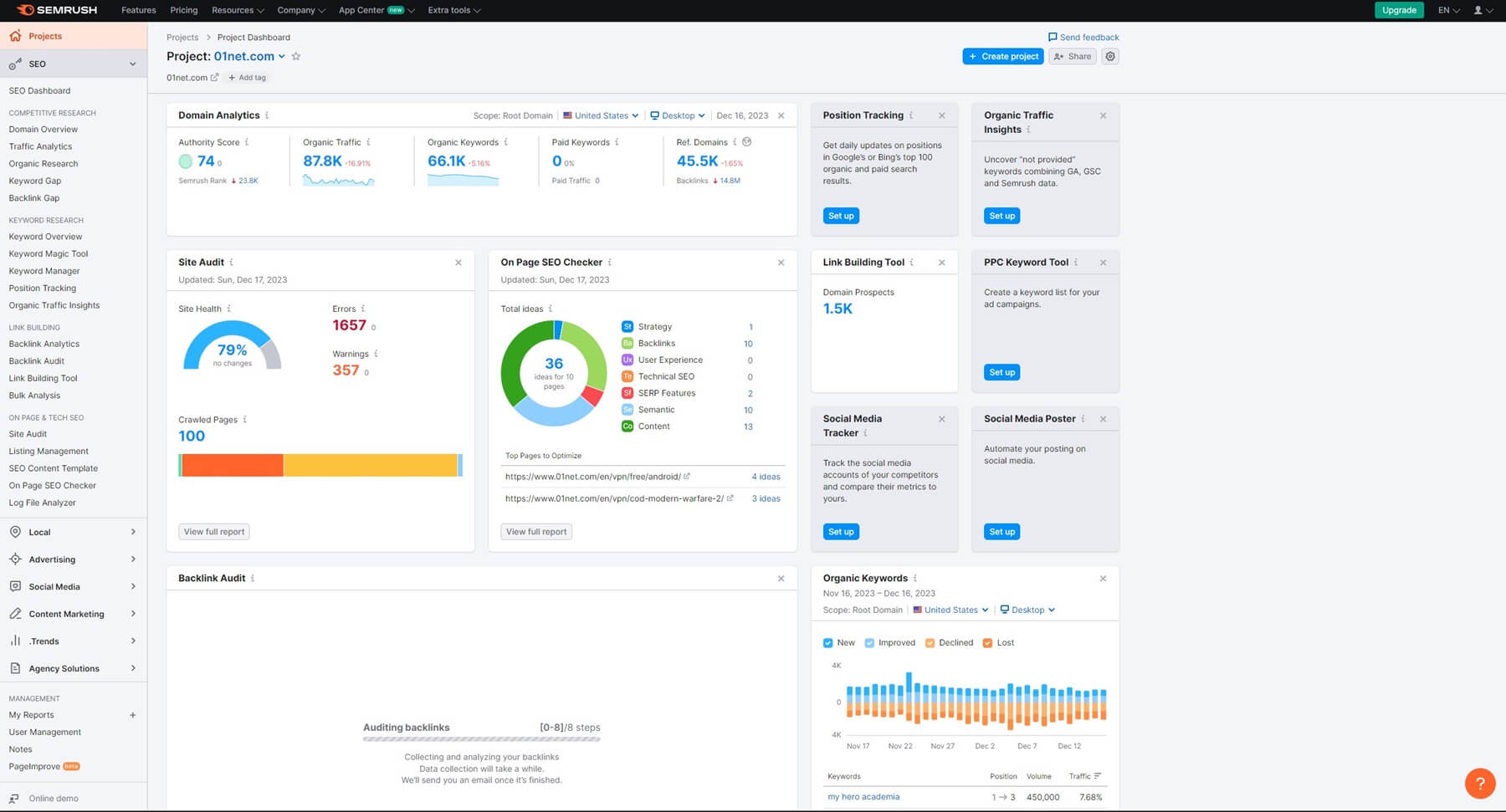
Best of all, you usually don’t have to dig deeper to find more meaningful data. The tool knows how to position the data you need in front and give it to you on a silver plate. Serpstat looks dated in comparison. We don’t like its interface.
It offers fewer tools and data but somehow manages to be MORE complex. Look at the left side and you’ll see piles of menus that look even more intimidating. Also, its graphs and overall aesthetics aren’t very eye-pleasing. Apart from looks, Serpstat is intuitive. But not as much as its rival.
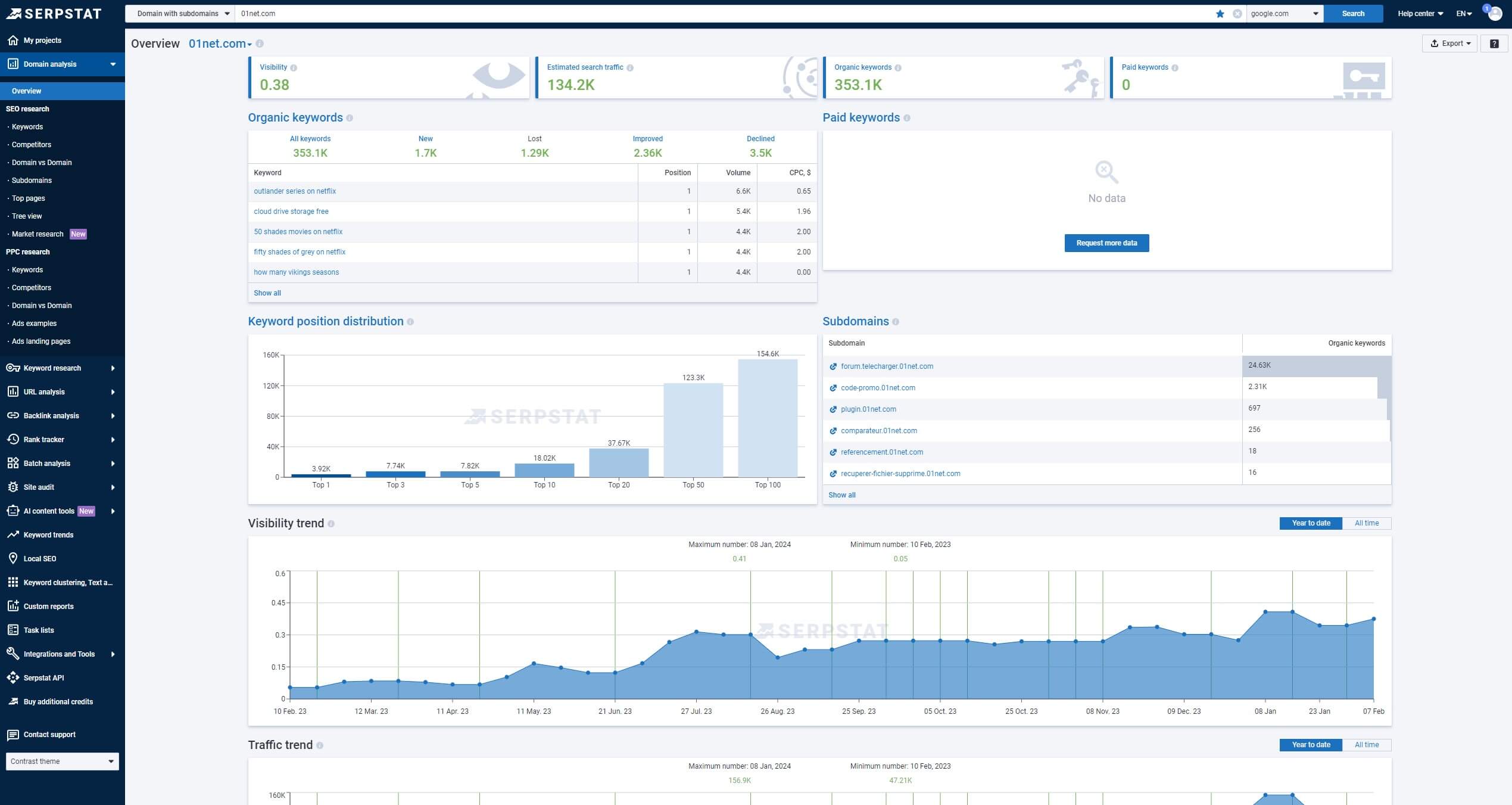
We had to use a separate menu for keyword suggestions and questions, whereas, Semrush displays them in the Keyword Overview menu. Mobile optimization is subpar in both cases, as these are complex SEO tools.
Just to be clear, these are web-based apps. If you want a desktop SEO tool, read our SEO PowerSuite comparison with Semrush to find out more. Generally, Semrush wins here and even from the images above, its modern look and ease of use can be seen.
Semrush vs Serpstat Price Comparison
Whether you choose Semrush or Serpstat, you’ll be greeted by rather simplistic pricing structures. This is great if you want to cherry-pick the plan according to your needs quickly and not bash your head thinking about what you got in the end.
Semrush
In Semrush, things are more than clear. It divides its plans into monthly and annual, where the latter are cheaper by 17%. That said, you’ll be paying $117.33/mo or so for the Pro plan, which is the cheapest price. Payments are upfront in the annual plan.
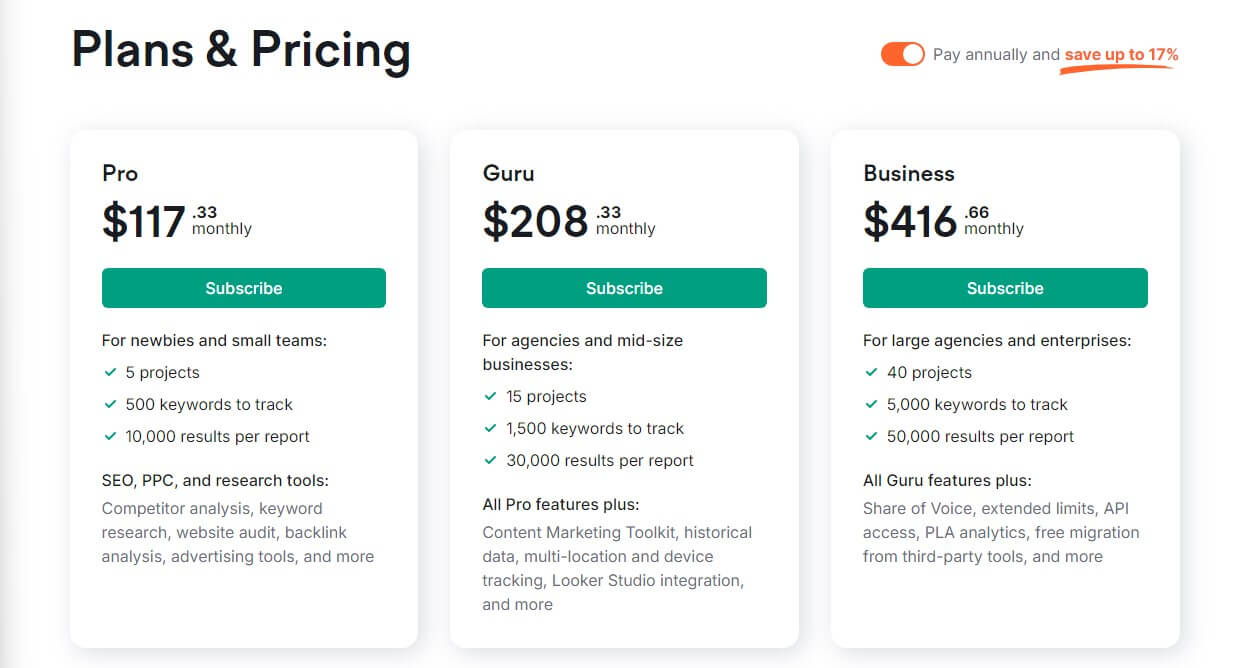
As always, we recommend the Guru plan which represents the best price-to-performance ratio. You have 15 projects, 1,500 keywords to track, and 30,000 results per report. Unlike the Pro plan, this one includes Content Marketing, historical data, and Looker Studio integration.
The Business plan is always pretty expensive and likely not recommended for “ordinary” users. Disappointingly, Semrush’s plans are for a single user only, no matter the plan you choose. Each consequent user will cost you from $45 to $100, depending on the plan.
In addition to everything, Semrush includes a 14-day free trial and a 7-day refund policy. Through our site, you can enjoy its 17% discount by using a Semrush coupon code. Actually, you don’t have to. Click the button below and get the discount right away.
Serpstat
Looking at the price of Serpstat, it looks like this SEO tool is cheaper. Its Individual plan starts at $50 a month. It lets you manage 5 projects and includes API access for Site Audit, whereas, API access for backlinks and search analytics is missing.
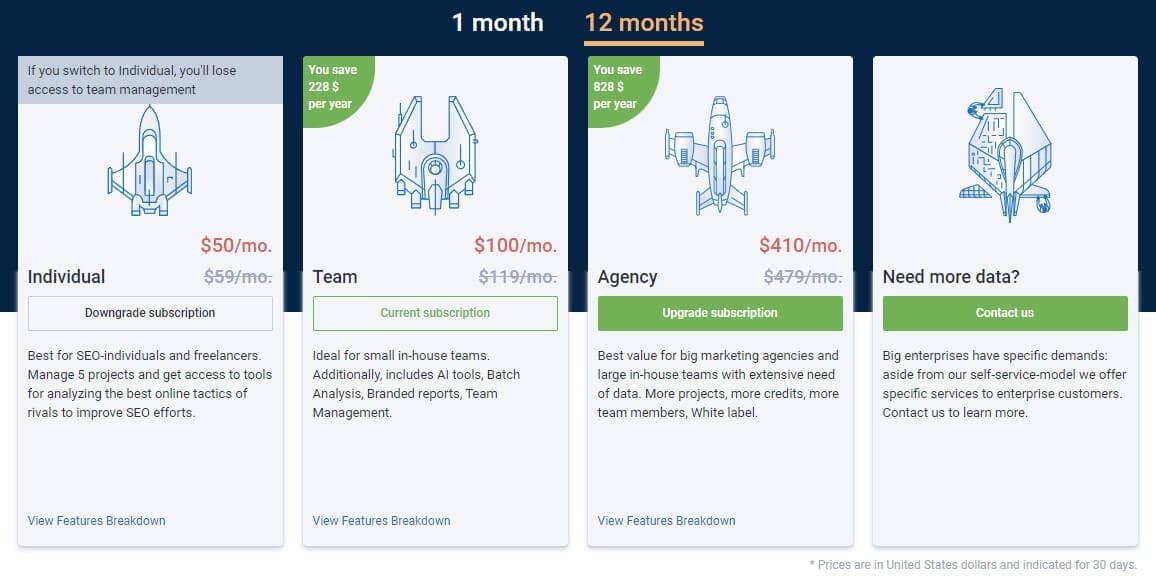
Mind you, we’re discussing its annual plans because monthly plans are more expensive. We prefer the Team plan because it includes every feature from this Serpstat vs Semrush duel. Moreover, it allows you to audit 150,000 pages compared to 30,000 in the Individual plan.
The Agency plan is $410 a month, which is quite a lot compared to $100 for the Team variant. However, you’ll get 2M API credits monthly, with 500,000 position checks each month. Serpstat even lets you go for a bespoke plan if you need more data.
An advantage over Semrush is that plans are made for multiple people – except for the Individual deal. For instance, the Team plan is for 3, while the Agency plan is for 30 users. At this price, we must admit that Serpstat offers plenty of value.
It allows for a 7-day free trial but the refund policy functions on a per-case basis. If the service thinks it should refund you, it will. If it isn’t justified, you won’t get a refund despite being dissatisfied for whatever reason.
Which One Is a Better Free SEO Tool?
As free SEO tools, neither is particularly generous. Serpstat lets you use it for free but you’ll be given a limited number of searches and requests. This means having to wait another day to be able to use the service again. Pretty annoying.
Semrush does the same. It allows for 10 free requests, be it related to site auditing, keyword research, or anything else. After that, Semrush will “brick” and be stuck to the screen that prompts you to get a free trial to keep using the tool.
However, it’s better than SE Ranking which has no “real” free plan. Compared to Serpstat, Semrush’s free plan is a tad better. Yes, it has limited requests but at least you get a heap of information for free, with very little skimping.
Customer Support
Customer support is more than solid in both cases. Semrush and Serpstat have multiple channels for contact, such as email, live chat, and in Semrush’s case, phone number. However, we mostly used live chat in both cases, as waiting times were short.
Bear in mind that neither Serpstat nor Semrush works 24/7. We tried reaching out to both on Saturday but we received a message that they’ll be back on Monday. You can always send an email and wait for a response if you find no luck with live chat.
Other support means include FAQs, video tutorials, and other helpful guides. Semrush and Serpstat, therefore, do not disappoint in this regard.
The Final Verdict: Semrush Wins Against Serpstat
To end this Serpstat vs Semrush duel for 2025, we declare Semrush the winner. In the end, the service is much better in every aspect, with Serpstat edging it out in merely a few instances. Granted, Semrush is way more expensive and that might be a problem.
However, if you want a top-quality SEO tool, you have to pay for it. As things stand, we have no doubt this tool is worth the asking price. If you’re on a tight budget, Serpstat might be great for performing site audits, keyword research, and AI-driven content creation.
But we should remind you about SE Ranking. This tool is the closest you can get to Semrush quality-wise. Yet, its price is way lower and the tool is more capable than Serpstat. In the end, you now know what is a wiser choice and that was the point of this comparison.